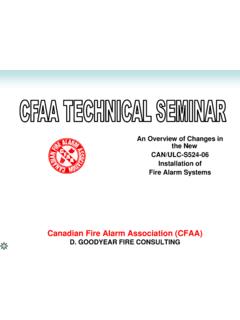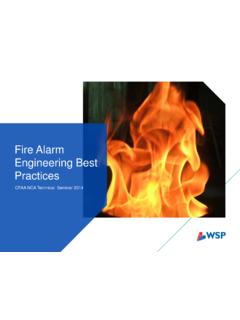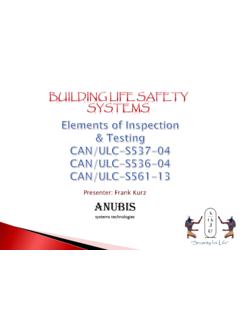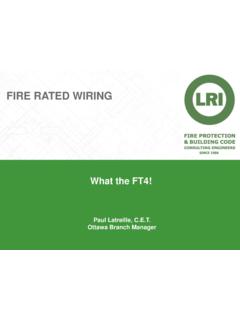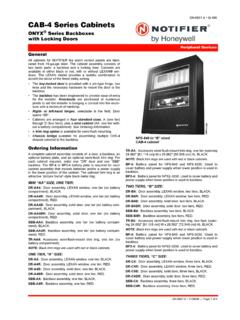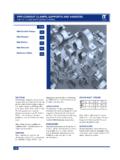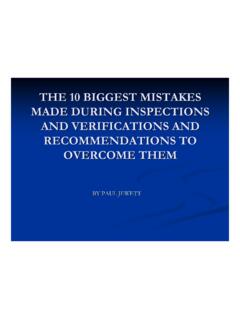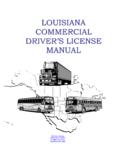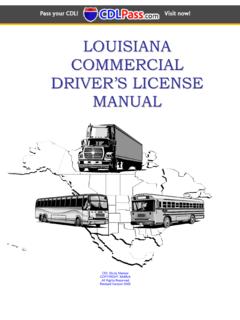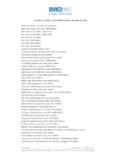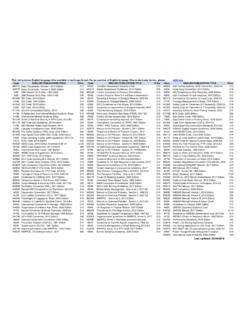Transcription of EST3 System Operation Manual - CFAA
1 est3 System OperationManualP/N 270382 Rev 30 AUG01 DEVELOPED BYEdwards Systems Technology6411 Parkland DriveSarasota, FL 34243(941) 739 4300 COPYRIGHT NOTICEC opyright 1996 2001. All rights Manual and the products it describes are copyrighted byEdwards Systems Technology, Inc. (EST). You may notreproduce, translate, transcribe, or transmit any part of thismanual without express, written permission from Manual contains proprietary information intended fordistribution to authorized persons or companies for the solepurpose of conducting business with EST. If you distribute anyinformation contained in this Manual to unauthorized persons,you have violated all distributor agreements and we may takelegal , Microsoft Mouse, and Windows are all trademarksof Microsoft Manual was designed and written by the EST TechnicalServices - Documentation Department, HISTORYR evisionDateReason for : System Addressing; Command MenuAdded: operations : Display examples.
2 Corrected minor typographical and revised concurrent with to incorporate security and access control System Operation ManualiContentAbout this Manual iiiThe est3 library ivImportant information viChapter 1 Introduction Operation processing features logical addresses 23-LCD operating instructions and indicators a status report groups groups hardware components hardware components security partitions security partitions security partitions security devices bypasses from security devices patrol groups groups the smoke detector sensitivity level event message routing the output state of a relay or LED reports the System time and date user access level passwords a panel holidays the panel history file alarm input devices 33-ASU operating instructions and indicators the Audio Source Unit audio zone controls 43-FTCU operating instructions and indicators System Operation ManualAppendix ASystem addresses format addresses / display module addresses addresses BOperation sequence charts System Operation ManualiiiAbout this manualThis Manual provides information on how to operate an EST3integrated System .
3 The information presented here is of a generalnature, since each site and System is unique. The est3 System atyour site has been designed by professionals to meet the specificrequirements of the fire and security codes in your refer to the site-specific instructions, provided by yourEST representative, to determine the exact Operation of Manual contains the following chapters: Chapter 1: Introduction: gives you a general description ofsystem functions and operations . Chapter 2: LCD operating instructions: provides detailedoperating instructions for the primary control module, the3-LCD module. Chapter 3: 3-ASU Audio Source Unit Operation : providesdetailed operating instructions for the 3-ASU audio sourceunit. Chapter 4: 3-FTCU operating instructions: providesdetailed operating instructions for the 3-FTCU firefightertelephone control unit. Appendix A: System addresses: contains figures that showyou how to determine various device addresses.
4 Appendix B: Operation sequence charts: contains tables orcharts that show the sequence of events, actions, anddisplays for the most common panel System Operation ManualThe est3 libraryEST3 documentsA library of documents and multi-media presentations supportsthe est3 life safety System . A brief description of each isprovided Installation and Service Manual (P/N 270380): Givescomplete information on how to install and service the EST3hardware. The Manual also includes installation information onselected Signature Series Installation Sheets (P/N 3100051): Is a convenientpackage of all est3 component installation sheets. This manualshows you the jumper settings and terminal connections for Online Help (P/N 180653): Provides full online support forconfiguring and programming a System using the est3 SystemDefinition Utility System Operation Manual (P/N 270382): Providesdetailed information on how to operate the System and International Installation Supplement Manual (P/N270925): Provides information specific to systems installedoutside the United States and Smoke Management Application Manual (P/N 270913):Provides information for designing, programming, and testing anEST3 smoke control Users Self-Study Course (P/N 270684): Contains a self-paced Manual and accompanying video.
5 The course is designedfor building personal, security guards, firefighters, and otherindividuals that may be required to operate the documentsIn addition to documents in the est3 library, you may find thefollowing documents Series Intelligent Smoke and Heat DetectorsApplications Bulletin (P/N 270145): Provides additionalapplications information on the Signature series smoke and heatdetector Series Component Installation Manual (P/N 270497):Contains detailed mounting and wiring information for allSignature series System Operation ManualvSpeaker Application Guide (P/N 85000-0033): Providesinformation on the placement and layout of speakers for firealarm signaling and emergency voice Applications Guide (P/N 85000-0049): Providesinformation on the placement and layout of strobes for fire System Operation ManualImportant informationLimitation of liabilityThis product has been designed to meet the requirements ofNFPA Standard 72; Underwriters Laboratories, Inc.
6 , Standard864; and Underwriters Laboratories of Canada, Inc., StandardULC S527. Installation in accordance with this Manual ,applicable codes, and the instructions of the Authority HavingJurisdiction is mandatory. EST shall not under anycircumstances be liable for any incidental or consequentialdamages arising from loss of property or other damages or lossesowing to the failure of EST products beyond the cost of repair orreplacement of any defective products. EST reserves the right tomake product improvements and change product specificationsat any every precaution has been taken during the preparation ofthis Manual to ensure the accuracy of its contents, EST assumesno responsibility for errors or warningThis equipment can generate and radiate radio frequency this equipment is not installed in accordance with this Manual ,it may cause interference to radio communications.
7 Thisequipment has been tested and found to comply within the limitsfor Class A computing devices pursuant to Subpart B of Part 15of the FCC Rules. These rules are designed to providereasonable protection against such interference when thisequipment is operated in a commercial environment. Operationof this equipment is likely to cause interference, in which casethe user at his own expense, will be required to take whatevermeasures may be required to correct the Canada informationNote: The Industry Canada label identifies certified certification means that the equipment meets certaintelecommunications network protective, operational, and safetyrequirements. Industry Canada does not guarantee the equipmentwill operate to the user s installing this equipment, users should ensure that it ispermissible to be connected to the facilities of the localtelecommunications company.
8 The equipment must also beinstalled using an acceptable method of connection. Thecustomer should be aware that compliance with the aboveconditions may not prevent degradation of service in System Operation ManualviiRepairs to certified equipment should be made by an authorizedCanadian maintenance facility designated by the supplier. Anyrepairs or alterations made by the user to this equipment, orequipment malfunctions, may give the telecommunicationscompany cause to request the user disconnect the should ensure for their own protection that the electricalground connections of the power utility, telephone lines, andinternal metallic water pipe System , if present, are connectedtogether. This precaution may be particularly important in : Users should not attempt to make such connectionsthemselves, but should contact the appropriate electricinspection authority, or electrician, as appropriateNote: The Load Number (LN) assigned to each terminal devicedenotes the percentage of the total load to be connected to atelephone loop which is used by the device, to preventoverloading.
9 The termination on a loop may consist of anycombination of devices subject only to the requirements that thesum of the Load Numbers of all the devices does not System Operation ManualEST3 System Operation 1 IntroductionSummaryThis chapter provides a general description of System functionsand their protection and function domains Operation state state details priorities processing event LEDs and queue buttons features patrol groups timers controls module buttons logical addresses rail modules System Operation ManualIntroductionSystem operating requirements can be configured based ongeographic location and protected premises North America, systems can be configured as protectedpremises (local) systems or as proprietary systems, both incompliance with NFPA the local mode, there is no requirement to acknowledge eachindividual event.
10 Each event message can be reviewed using thePrevious and Next buttons. System events that automaticallyrestore will automatically be removed from the message queue,without requiring the operator to view a restoral the proprietary mode, each event must be individuallyacknowledged by pressing the respective message acknowledgebutton. The Previous and Next button functions are not availablein the proprietary mode. Operators are required to acknowledgeboth an event and its restoration to remove it from a : Alarm and supervisory events do not automaticallyrestore. They remain in their respective message queues until thesystem is manually protectionCertain front-panel controls and command menu functions arepassword-protected and have a user access level that isdetermined by the marketplace setting. The four user accesslevels are detailed in Table access level is given a default password that should bechanged once the panel is put into service.
